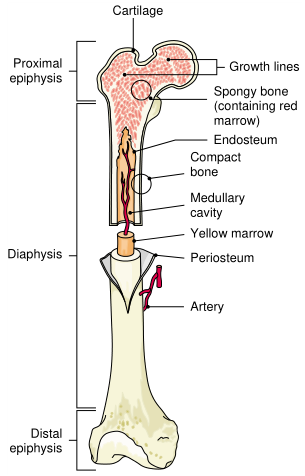A typical long bone (Fig. 1) has a shaft or diaphysis composed of compact bone tissue. Within the shaft is a medullary cavity containing the yellow form of bone marrow, which is high in fat. The irregular epiphysis at either end is made of a less dense, spongy bone tissue containing the blood-forming red bone marrow. A thin layer of cartilage covers the epiphysis and protects the bone surface. Between the diaphysis and the epiphysis at each end of the bone, in a region called the metaphysis, is the growth region or epiphyseal plate. When the bone stops growing in length, this area becomes fully calcified but remains visible as the epiphyseal line. The thin layer of fibrous tissue that covers the outside of the bone, the periosteum, nourishes and protects the bone and also generates new bone cells for growth and repair.

FIGURE 1. Structure of a long bone. (Reprinted with permission from Cohen BJ, Wood DL. Memmler's The Human Body in Health and Disease. 9th Ed. Philadelphia: Lippincott Williams & Wilkins, 2000.)
Long bones are found in the arms, legs, hands, and feet. Other types of bones are described as flat (i.e., cranial bones), short (i.e., wrist and ankle bones), or irregular (i.e., facial bones and vertebrae).
责任编辑:admin
上一篇:医学文章阅读——Metabolic Bone Diseases
下一篇:医学文章阅读——Divisions of the Skeleton

微信公众号搜索“译员”关注我们,每天为您推送翻译理论和技巧,外语学习及翻译招聘信息。